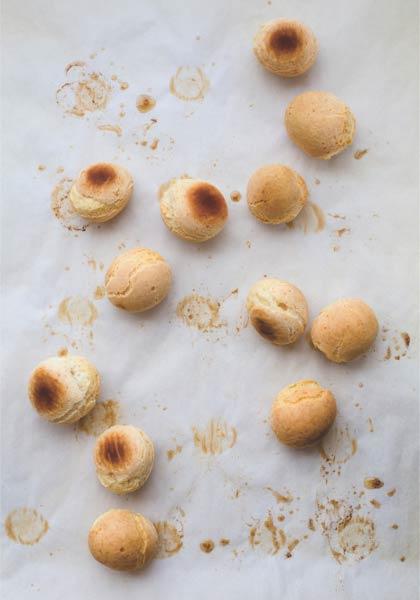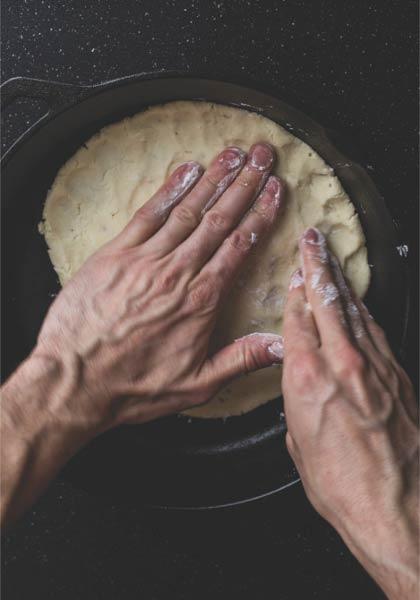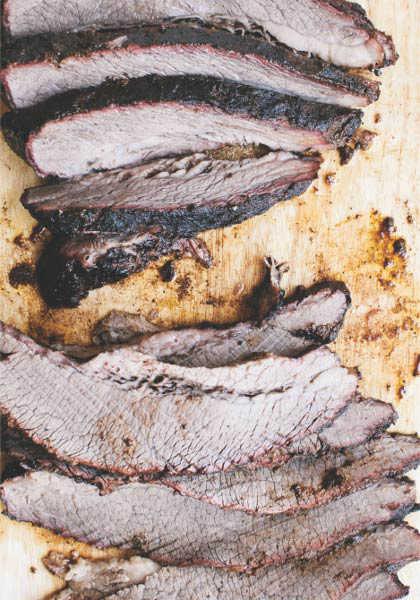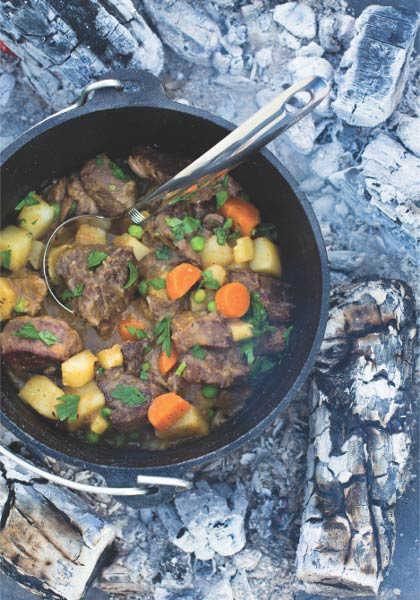The Ancestral Table: Traditional Recipes for a Paleo Lifestyle (16 page)
Read The Ancestral Table: Traditional Recipes for a Paleo Lifestyle Online
Authors: Russ Crandall

1 1/2 CUPS TAPIOCA STARCH
1/4 CUP HEAVY CREAM
1/4 CUP WATER
1 TBSP. BUTTER
1/2 TSP. SEA SALT
1 EGG, BEATEN
1/2 CUP GRATED HARD CHEESE (SUCH AS PARMESAN OR SHARP CHEDDAR)
1. Put the tapioca starch in a large mixing bowl and set aside. In a saucepan, combine the cream, water, butter, and salt and warm on medium-low heat. Once the butter melts and the liquid just starts to bubble, remove from the heat and stir it into the tapioca starch. Let the mixture cool for 5 minutes. Preheat the oven to 400°F.
2. Add the beaten egg to the mixture and knead with your hands. Add the cheese and mix together until it’s dough-like. Add more starch and cheese if needed.
3. Roll the dough into 1" balls; you should be able to make 15-20 balls. Place the balls on a baking sheet and bake until golden brown, 15-20 minutes. You can also freeze the balls prior to baking to have a premade snack that can be ready after 20-25 minutes of baking.
4. To make breadsticks, form the dough into breadstick shapes before baking (see the picture
here
).

Pizza
Pizza can be traced back to ancient Greece, where they covered bread with oil and cheese and reheated it. Italy is credited for adding tomatoes to pizza following their introduction from the New World in the 16th century. Surprisingly, the combination of tomatoes and cheese wasn’t popular for hundreds of years, mostly until the famous Pizza Margherita incident captured on the cover of this book. The combination of tomatoes, mozzarella cheese, and basil leaves was served to Queen Margherita in 1889 to represent the Italian flag.
Pizzerias existed in the United States at the turn of the 20th century, but they were frequented mostly by Italian immigrants. Soldiers returning from the European campaign of World War II raved about pizza, and it became the sensation it is now almost overnight.
SERVES:
3-4 (MAKES 2 PIZZAS)
PREP TIME:
10 MINUTES
COOKING TIME:
40 MINUTES (FOR 2 PIZZAS)
1 1/2 CUPS TAPIOCA starch
1/4 CUP HEAVY CREAM
1/4 CUP WATER
2 TBSP. BUTTER
1/2 TSP. SEA SALT
1 EGG, BEATEN
3/4 CUP GRATED PARMESAN CHEESE (OR ANY HARD CHEESE)
PINCH OF WHITE PEPPER
1/4 TSP. DRIED OREGANO
1/2 CUP PIZZA SAUCE (BLENDED BASIC RED SAUCE,
SEE HERE
), DIVIDED
2/3 CUP GRATED MOZZARELLA, DIVIDED
TOPPINGS AS DESIRED
1. Put the tapioca starch in a large mixing bowl and set aside. In a saucepan, combine the cream, water, butter, and salt and warm on medium-low heat. Once the butter melts and the liquid just starts to bubble, remove from the heat and stir it into the tapioca starch. Let the mixture cool for 5 minutes. Preheat the oven to 500°F.
2. Add the beaten egg to the mixture and knead together with your hands. Add the Parmesan cheese, white pepper, and oregano and mix together until it’s dough-like. Add more starch and cheese if needed. Depending on the ambient temperature of your kitchen, the starch can sometimes melt into a gooey consistency—if this happens, add more cheese until it’s doughy enough to form into a pizza, and it’ll turn out fine.
3. Split the dough in half, then stretch out each half into the thinnest disc possible without tearing. Put one half of the dough in a 8"-10" cast-iron skillet, spreading to the edges of the skillet with your fingers. Try to get it as thin as possible. With a fork, poke some holes in the dough to let air pass through.
4. Bake in the center of the oven for 6 minutes, then take it out and put it on the stovetop. Add half of the pizza sauce, mozzarella, and toppings—whatever you like. This step is important because it gives the dough time to cook through without burning the toppings.
5. Put the pizza back in the oven and bake for another 8-10 minutes or until the cheese starts to brown. For extra-crispy toppings, broil for the last minute or two of cooking.
6. Repeat the process with the other half of the dough.
7. This pizza also cooks well on a pizza stone. For best results, bake the crust for 8 minutes instead of 6 during the first stage of cooking.



Hearty Stew
Stew is a catchall term for solid ingredients cooked in liquid. It is one of the most ancient forms of cooking, and it’s no surprise that the concept is often associated with comfort foods. After all, stews are irreversibly linked to human survival; they make raw foods edible and tough meats tender. As Paul mentioned in the Foreword, the first cooking tools used to make stews were likely animal hides. Turtle and mollusk shells were also used as ancient cookware.
This stew recipe has no direct point of origin, although it is not dissimilar to many European stews, like the French pot-au-feu. It can be made with beef, lamb, or bison.
SERVES:
4
PREP TIME:
20 MINUTES
COOKING TIME:
2 1/2 HOURS
2 LBS. STEW MEAT, CHUCK ROAST, OR SIMILAR, CUT INTO 1 1/2" CHUNKS
1/2 TSP. SEA SALT
1/2 TSP. BLACK PEPPER
1 TBSP. COCONUT OIL
1 MEDIUM ONION, FINELY CHOPPED
2 CLOVES GARLIC, MINCED
1/4 CUP RED WINE
1 CUP BEEF STOCK OR BROTH (
SEE HERE
)
1 CUP CHICKEN STOCK OR BROTH (
SEE HERE
)
1/2 TSP. DRIED THYME
2 BAY LEAVES
2 LARGE RUSSET POTATOES, PEELED AND CUT INTO BITE-SIZED CHUNKS
2 CARROTS, CUT INTO BITE-SIZED CHUNKS
1 PARSNIP, CUT INTO BITE-SIZED CHUNKS
1/2 CUP FROZEN PEAS
1 SMALL HANDFUL FRESH PARSLEY, CHOPPED
1. Season the meat with the salt and pepper. In a Dutch oven, heat the oil on medium until shimmering, about 2 minutes. Add the meat and brown, in batches if needed, turning every few minutes. Set the browned meat aside.
2. Preheat the oven to 300°F. Add the onion to the Dutch oven and sauté until softened, about 5 minutes. Add the garlic and sauté for another 30 seconds, then add the beef and its accumulated juices, wine, broths, thyme, and bay leaves. Add more broth if needed to mostly cover the beef. Bring to a simmer, cover, and put in the oven to roast for 1 hour 15 minutes.
3. Add the potatoes, carrots, and parsnip to the Dutch oven. Roast for another 40 minutes, until the vegetables and meat are tender. Remove from the oven, uncover, and place on the stovetop to simmer on low heat as you prepare the vegetable puree below; discard the bay leaves.
4. Using a ladle or large spoon, remove some of the potatoes, carrots, and parsnips, about 1 cup total, and 1/2 cup of the broth. Blend the vegetables and broth into a smooth puree, then return it to the Dutch oven, stirring until thick, about 1 minute. Carefully stir in the peas, then cover and simmer for 5 minutes. Season with salt and pepper to taste, garnish with fresh parsley, and serve.

Eye of Round Roast
Eye of round is cut from a section of the cow’s hindquarters. It is a very lean and tough cut of meat due to the fact that it gets a lot of use. While braising is the most popular method of tenderizing lean meats, roasting at high heat can also produce a tender, flavorful dinner. This is my family’s go-to roasting technique, as it allows us to transform a cheap cut of beef into a succulent roast in a relatively short time.
This recipe can be used with similar lean boneless roasts, like bottom round or rump roast. Adding root vegetables to the skillet or baking sheet adds another tasty dimension to your meal.
SERVES:
6-8
PREP TIME:
45 MINUTES
COOKING TIME:
1-2 HOURS
1 TSP. KOSHER SALT
1 TSP. COARSE-GROUND BLACK PEPPER
6 CLOVES GARLIC, MINCED
1/2 TSP. DRIED THYME
3-4 LBS. EYE OF ROUND ROAST (OR SIMILAR LEAN BONELESS ROAST)
1 TBSP. RED WINE
2 TBSP. WATER
1. Combine the salt, pepper, garlic, and thyme in a small bowl. Pat the roast dry with paper towels; rub the seasoning mixture all over the roast, then let it sit out for 30 minutes at room temperature. Preheat the oven to 500°F.
2. Place the roast on a baking sheet or stainless-steel skillet, fatty side up, and roast for 7 minutes per pound. Reduce the heat to 180°F and roast until the internal temperature reaches 135-140°F, about 1 hour. This process will create a roast that is dark brown and crusty on the outside and pink in the middle. Start checking the roast’s internal temperature with a quick-read thermometer at the 30-minute mark, and every 15 minutes after that. Use these temperatures to gauge the roast’s doneness (for best results, aim for medium-rare to medium-well):
• 125°F = rare
• 130°F = medium-rare
• 135°F = medium
• 150°F = medium-well
• 160°F = well-done
Remove the roast and set on a cutting board to rest for 5 minutes, then carve into thin slices.
3. If you used a stainless-steel skillet, place the skillet and the roast drippings on the stovetop; otherwise, transfer the drippings to a saucepan. Heat the pan on medium for 1 minute, then add the red wine and water, deglazing the pan and whisking to break up any chunks. Deglaze for 2 minutes, then strain through a fine mesh strainer and pour over the sliced roast.